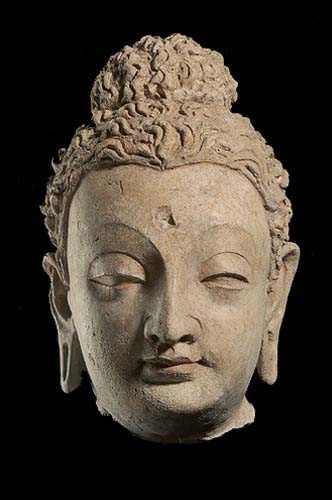

Head of the Buddha: Gandhara region, 4th/5th century, stucco, height: 28cm.
Source: http://asianart.com/eskenazi/buddha.html
(downloaded Feb. 2001)
This commentary provided by John Eskenazi, Ltd., the gallery that was showing the image:
"His face with benign meditative expression, arched eyebrows in relief, heavy-lidded almond-shaped eyes, and bow-shaped mouth with remains of red polychrome on the lips. The finely carved ears with elongated pierce lobes, and his hair arranged in rows of crescentic curls and surmounted by a domed usnisa.A finely moulded stucco head of Buddha, with his eyes half closed in meditative pose, and the face as a whole emanating a deep sense of benevolence and determination. The long curly hair, typical of the genre, is gathered in a loosely arranged chignon. The features have been heavily influenced by the classic prototype of the Hellenistic models. The medium for such sculptures in Gandhara alternated between schist and stucco, schist being rather more common. One theory is that stucco came later than schist, being adopted only when schist became difficult to obtain. This may account for the later dating for this piece. The first images of the Buddha and Bodhisattvas seem to have been produced more or less simultaneously in Mathura and Gandhara in the first century AD. In representing the Buddha the artists were asked to portray an adept or teacher, but so to idealise it that the figure would be worthy to rank as a sacred representation and cult image. In accordance with Buddhist texts the artists added to the images the distinguishing marks (lakshanas) of a Buddha or Universal Monarch (chakravartin) that could be depicted plastically. These lakshanas included the usnisa, the protuberance on the skull indicating wisdom and concealed by a top-knot, the urnaor tuft of hair between the eyebrows which may represent the yogic third eye signifying spiritual insight, and a web between fingers and toes. Other features which characterise the fully developed Gandhara style by the third century AD are the elongated earlobes recalling the heavy princely earrings of the Buddha's early life, and an undulating, wavy hairstyle. These features all heavily impregnated with Graeco-Roman influences.
Gandhara gives its name to the much larger artistic province bounded roughly to the north by the mountains of the Hindu Kush and to the south and west by the River Indus, incorporating much of contemporary Afghanistan and Northwestern Pakistan. Gandharan remains are now recognised from the Oxus river on the Afghan border with Uzbekistan to the Rawalpindi District east of the Indus. North of the Peshawar valley they occur in the Swat valley and in adjacent Buner and Bajaur. Most of what is considered Gandharan work was produced between the first and sixth centuries AD, when, significantly, the region enjoyed unparalleled peace and prosperity as part of the large Kushan empire which controlled the trade routes and Silk Road linking China, India and classical Greece and Rome, thus enabling Gandhara in this period to become literally the cross-roads of Asian trade, commerce and culture. This commerce led to the growth of cosmopolitan cities and a large merchant class, who along with the early Kushan kings provided the cultural climate and patronage for the development of Gandharan art."